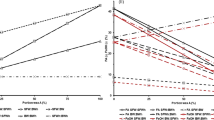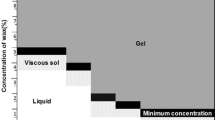Abstract
The effects of cooling rate during melt crystallization of rice bran wax, sunflower wax, candelilla wax and a commercial peanut butter stabilizer in peanut oil were evaluated and correlated to their oil binding capacity. Rapid cooling upon crystallization decreased crystal length, decreased network pore area fraction, increased the fractal dimension of the crystal network, and lead to an increase in the oil binding capacity. Oleogels structured using 1 % sunflower wax exhibited the highest oil binding capacity, followed by candelilla wax and rice bran wax gels. The oil binding capacity of the commercial stabilizer was the lowest, but could be improved by crystallizing the material under high cooling rates. Linear correlation analysis revealed that the network fractal dimension decreases as pore area fraction increases, which was correlated to a greater oil loss. In general, the oil binding capacity of a gel can be significantly improved if the pore area fraction is decreased below 96 %, demonstrating how the fractal dimension and pore area fraction of a gel network can be modulated to tailor oil binding capacity.


Similar content being viewed by others
References
R. Wang, X.-Y. Liu, J. Xiong, J. Li, J. Phys. Chem. B 110, 7275 (2006)
M.A. Rogers, A.G. Marangoni, Cryst. Growth Des. 8, 8 (2008)
A.G. Marangoni, D. Tang, A.P. Singh, Chem. Phys. Lett. 419, 259 (2006)
M.A. Rogers, Soft Matter 4, 1147 (2008)
N.K. Ojijo, I. Neeman, S. Eger, E. Shimoni, J. Sci. Food Agric. 84, 1585 (2004)
S. Da Pieve, S. Calligaris, E. Co, M.C. Nicoli, A.G. Marangoni, Food Biophys. 5, 211 (2010)
M.A. Rogers, A.G. Marangoni, Langmuir 25, 8556 (2009)
E. Co, A.G. Marangoni, J. Am. Oil Chem. Soc. 90, 529 (2013)
J.F. Toro-Vazquez, J.A. Morales-Rueda, E. Dibildox-Alvarado, M. Charó-Alonso, M. Alonzo-Macias, M.M. González-Chávez, J. Am. Oil Chem. Soc. 84, 989 (2007)
J.A. Morales-Rueda, E. Dibildox-Alvarado, M.A. Charó-Alonso, R.G. Weiss, J.F. Toro-Vazquez, Eur. J. Lipid Sci. Technol. 111, 207 (2009)
H.-S. Hwang, S. Kim, M. Singh, J.K. Winkler-Moser, S.X. Liu, J. Am. Oil Chem. Soc. 89, 639 (2011)
D. Zulim Botega, Application of rice bran wax organogel to substitute solid fat and enhance unsaturated fat content in ice cream (Univeristy of Guelph, 2012), https://atrium.lib.uoguelph.ca/xmlui/handle/10214/3291 Accessed Jan 2015
A.J. Gravelle, S. Barbut, A.G. Marangoni, Food Funct. 4, 153 (2013)
A.I. Blake, E.D. Co, A.G. Marangoni, J. Am. Oil Chem. Soc. 91, 885 (2014)
A. Blake, A.G. Marangoni, Food Struct. 3, 30 (2015)
K.J. Aryana, A.V.A. Resurreccion, M.S. Chinnan, L.R. Beuchat, J. Food Sci. 68, 1301 (2003)
MIT Non-Newtonian Fluid Dynamics Research Group, http://web.mit.edu/nnf/education/wettability/wetting.html. Accessed 7 July 2015
A. Lafuma, D. Quere, Nat. Mater. 2, 457 (2003)
M.S.G. Razul, C.J. MacDougall, C.B. Hanna, A.G. Marangoni, F. Peyronel, E. Papp-Szabo, D.A. Pink, Food Funct 5, 2501 (2014)
A.G. Marangoni, Trends Food Sci. Technol. 13, 37 (2002)
D. Tang, A.G. Marangoni, J. Am. Oil Chem. Soc. 83, 377 (2006)
Acknowledgements
The authors would like to acknowledge the financial support provided by the Natural Science and Engineering Research Council of Canada.
Conflict of Interests
There are no conflicts of interest.
Author information
Authors and Affiliations
Corresponding author
Rights and permissions
About this article
Cite this article
Blake, A.I., Marangoni, A.G. The Use of Cooling Rate to Engineer the Microstructure and Oil Binding Capacity of Wax Crystal Networks. Food Biophysics 10, 456–465 (2015). https://doi.org/10.1007/s11483-015-9409-0
Received:
Accepted:
Published:
Issue Date:
DOI: https://doi.org/10.1007/s11483-015-9409-0




